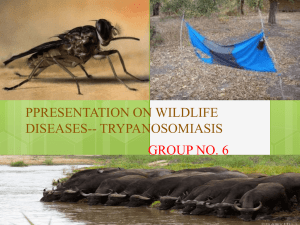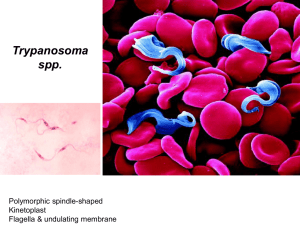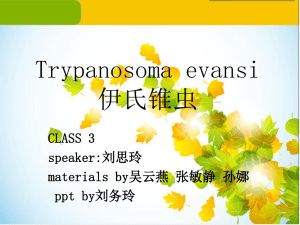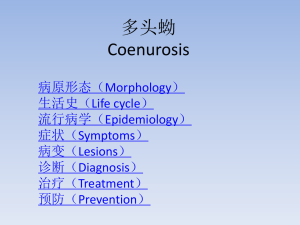comparative plasma biochemical changes and susceptibility of
advertisement
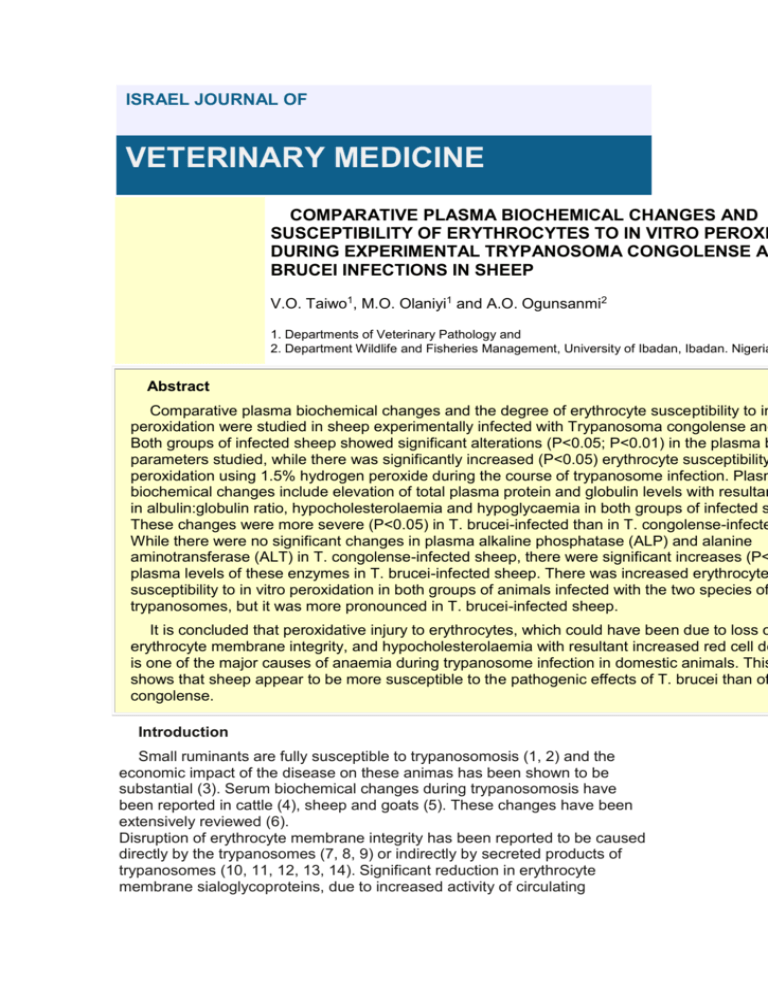
ISRAEL JOURNAL OF VETERINARY MEDICINE Vol. 58 (4) 2003 COMPARATIVE PLASMA BIOCHEMICAL CHANGES AND SUSCEPTIBILITY OF ERYTHROCYTES TO IN VITRO PEROXI DURING EXPERIMENTAL TRYPANOSOMA CONGOLENSE A BRUCEI INFECTIONS IN SHEEP V.O. Taiwo1, M.O. Olaniyi1 and A.O. Ogunsanmi2 1. Departments of Veterinary Pathology and 2. Department Wildlife and Fisheries Management, University of Ibadan, Ibadan. Nigeria Abstract Comparative plasma biochemical changes and the degree of erythrocyte susceptibility to in peroxidation were studied in sheep experimentally infected with Trypanosoma congolense and Both groups of infected sheep showed significant alterations (P<0.05; P<0.01) in the plasma b parameters studied, while there was significantly increased (P<0.05) erythrocyte susceptibility peroxidation using 1.5% hydrogen peroxide during the course of trypanosome infection. Plasm biochemical changes include elevation of total plasma protein and globulin levels with resultan in albulin:globulin ratio, hypocholesterolaemia and hypoglycaemia in both groups of infected s These changes were more severe (P<0.05) in T. brucei-infected than in T. congolense-infecte While there were no significant changes in plasma alkaline phosphatase (ALP) and alanine aminotransferase (ALT) in T. congolense-infected sheep, there were significant increases (P< plasma levels of these enzymes in T. brucei-infected sheep. There was increased erythrocyte susceptibility to in vitro peroxidation in both groups of animals infected with the two species of trypanosomes, but it was more pronounced in T. brucei-infected sheep. It is concluded that peroxidative injury to erythrocytes, which could have been due to loss o erythrocyte membrane integrity, and hypocholesterolaemia with resultant increased red cell de is one of the major causes of anaemia during trypanosome infection in domestic animals. This shows that sheep appear to be more susceptible to the pathogenic effects of T. brucei than of congolense. Introduction Small ruminants are fully susceptible to trypanosomosis (1, 2) and the economic impact of the disease on these animas has been shown to be substantial (3). Serum biochemical changes during trypanosomosis have been reported in cattle (4), sheep and goats (5). These changes have been extensively reviewed (6). Disruption of erythrocyte membrane integrity has been reported to be caused directly by the trypanosomes (7, 8, 9) or indirectly by secreted products of trypanosomes (10, 11, 12, 13, 14). Significant reduction in erythrocyte membrane sialoglycoproteins, due to increased activity of circulating neuraminidases (sialidases) has also been reported to play a significant role in the development of anaemia in African animal trypanosomosis (15, 16, 17). These phenomena have been reported to be responsible for early sequestration and destruction of erythrocytes by cells of the mononuclear phagocytic series and subsequent anaemia during trypanosomiasis (18). Erythrocyte peroxidation has been observed to be one of the factors, which play an important role in the pathogenesis of anaemia in acute trypamosomosis in mice infected with T. brucei (19). Trypanosomes and activated phagocytes (macrophages and neutrophils) are known to elaborate sialidases (15, 20), proteases (14, 21), reactive oxygen radicals such as O2=, OH- an erythrocyte membranes leading to their rapid destruction during infection (16, 17, 18). This study was designed to investigate some plasma biochemical changes in sheep and the dynamics of in vitro erythrocyte peroxidation during T. congolense and T brucei infections in order to determine the possible correlation with the degree of susceptibility of sheep to the infections. Materials and Methods Infection of Animals with Trypanosomes Twenty, (10 male and 10 female) healthy West African dwarf (WAD) sheep aged between 1-11/2 years and weighing between 14.5 and 16kg purchased at a local market in Ibadan, Nigeria were used for this experiment. They were housed in the Small Animal Unit of the Teaching and Research Farm, University of Ibadan, Nigeria. The animals were fed a combination of grass and legume hay supplemented with commercial sheep concentrates. All had access to fresh clean water ad libitum. Two species of trypanosomes used in this study, Trypanosoma congolense (Binchi Bassa Strain) and T. brucei (Lafia Strain) were obtained from Nigerian Institute for Trypanosomasis Research (NITR), Vom. The animals were divided into two groups, A and B, each consisting of 5 males and 5 females. Groups A animals were each given 3.5x106 T. congolense, while group B animals were also given 3.5x106 T. brucei all in 1ml of sterile normal saline by intraperitoneal (i.p.) inoculation. Blood Collection and Plasma Biochemistry Ten millilitres (ml) of blood was collected from each animal on days 0, 7, 14, 21, 28, 35, 42, 49 and 56 days post-infection (p.i.) by jugular venapucture into tubes containing disodium ethylene diamine tetraacetic acid (Na-EDTA) anticoagulant. Plasma was obtained from the blood sample by centrifugation at 2,000g for 10 minutes at 27oC. Total plasma protein, albumin and globulin levels were determined as described (2); plasma glucose level was determined by glucose oxidase method (24). Total plasma cholesterol level was measured using the method described (25). The concentrations of alanine aninotransferase (ALT) and aspartate aminotransferase (AST) in the plasma samples were determined spectrophotometrically (26). The level of alkaline phosphatase (ALP) in the plasma samples was determined as described (27). In vitro Erythrocyte Peroxidation: One trillion (109) washed erythrocytes per animal, obtained from the middle third of packed red cells after centrifugation, were used for this assay. The in vitro erythrocyte peroxidation assay was carried out on days 0, 7, 14, 21, 28, 35, 42, 49 and 56 p.i. as described (28). Briefly, the washed erythrocytes were suspended in 2ml of 0.9% saline solution in labeled sample tubes. To each of these was added 0.5ml 1.5% hydrogen peroxide. Washed erythrocytes suspended in 2.5ml of 0.9% saline solution served as the control. The samples were incubated at 37oC for 90 minutes after which the reaction was stopped with 0.5ml of 10% trichloroacetic acid. The suspension was centrifuged at 1,500g for 10 minutes followed by filtration through Whatman No. 1 filter paper. To each filtrate was added 0.75ml of 0.67% thiobarbituric acid and then re-heated at 100oC for 20 minutes. The samples were cooled to 20oC and the by-products of peroxidation (thiobarbituric acid reactive substances) were measured spectrophotometrically at 535nm. Statistical analysis of data The data were subjected to statistical analysis to test any significant differences between the two groups using analysis of variance (ANOVA) (29). Results Changes in levels of plasma proteins and enzymes AST, ALT and ALP in the T. congolense and T. brucei-infected sheep are shown on Table 1. The levels of total plasma protein levels remained unchanged from the preinfected levels for the first three weeks post-infection (p.i.). On the 28th day p.i., the plasma protein levels showed significant increases (p<0.05) from 5.85±0.24g/dl and 6.75±0.19g/dl at pre-infection to 8.90±0.12g/dl and 8.13±0.18g/dl in groups A and B, respectively (Table 1). The levels of plasma globulin showed significant (p<0.05) increases above pre-infection levels in both groups A and B from 28 dpi and 21 dpi, respectively till the experiment was terminated on 56 days p.i. (Table 1). No significant changes were observed in the levels of plasma albumin in both groups throughout the experiment. While the plasma levels of ALP and AST showed no significant changes (p>0.05) from the pre-infection levels in group B animals, those in group A had significant increases (p<0.05) in both ALP and AST levels in plasma from 14th day p.i. and thereafter remained above the pre-infection level till the termination of the experiment. There were no significant changes (p>0.05) in the levels of ALT in all the infected animals as these remained consistently within the pre-infection ranges throughout the course of the experiment (Table 1). Days post-infection Parameter 0 7 14 21 28 35 42 49 5.9±0.2d* 6.3±0.2f 6.1±0.1d 6.2±0.2f 6.1±0.1d 6.4±0.2f 6.6±0.1c 6.9±0.1e 8.9±0.1b 8.1±0.2c 8.6±0.2b 8.4±0.2c 8.8±0.2b 8.2±0.1c 9.3±0.2a 9.0±0.3a 3.5±0.2ab 3.1±0.1b 3.2±0.1a 3.2±0.3ab 3.4±0.3ab 3.0±0.2b 3.2±0.3ab 3.3±0.2ab 3.5±0.1a 3.6±0.1a 3.2±0.2ab 3.3±0.3ab 3.2±0.2ab 3.1±0.2b 3.0±0.1b 3.3±0.3ab Globulin (g/dl) Group A Group B 2.4±0.2d 3.2±0.1e 2.9±0.1c 3.0±0.2e 2.7±0.3c 3.4±0.1d 3.4±0.2b 3.6±0.3d 5.4±0.3b 4.5±0.2c 5.4±0.3b 5.1±0.2b 5.6±0.3b 5.1±0.3b 6.3±0.4a 5.7±0.2a ALP (IU/l) Group A Group B 68.7±4.2c 69.5±1.5a 68.1±1.3c 66.9±1.7ab 74.8±1.5b 67.9±1.5ab 75.7±3.8ab 68.0±1.8ab 78.4±1.2a 65.7±1.5b 76.4±4.1ab 69.8±1.5a 77.4±2.9a 67.6±1.2ab 78.3±2.7 68.1±1.6 5.5±0.3d 4.9±0.7a 5.4±0.1d 5.3±0.3a 8.4±0.5a 4.8±0.6a 8.2±0.4a 5.2±0.6a 7.2±0.3c 5.0±0.8a 8.4±0.9a 5.3±0.6a 7.6±0.2b 5.2±0.5a 7.8±0.6b 5.1±0.6a 5.4±0.3a 5.3±0.2a 5.2±0.1a 5.4±0.3a 5.2±0.2a 5.3±0.3a 5.6±0.4a 5.3±0.2a 5.6±0.4a 5.4±0.4a 5.5±0.2a 5.3±0.2a 5.3±0.5a 5.5±0.5a 5.3±0.3a 5.2±0.3a Total plasma protein (g/dl) Group A Group B Albumin (g/dl) Group A Group B AST (IU/l) Group A Group B ALT (IU/l) Group A Group B *Values on the same row with different superscripts differ significantly (P<0.05). The results of changes in plasma cholesterol, glucose and in vitro erythrocyte peroxidation are shown in Figs. 1, 2 and 3, respectively. Animals in both groups developed hypocholesterolaemia from the 7th day p.i., which became more severe with progression of infection till the experiment was terminated. However, animals in group B suffered more severe hypocholesterolaemia (p<0.01) than those in group A (Fig. 1). Similarly, animals in both groups developed hypoglycaemia from 14 days p.i. onwards. Hypoglycaemia was however, more pronounced in group B animals on 14, 21and 35 days p.i. (Fig. 2). Fig 1: Changes in plasma cholesterol levels in WAD Fig 2: Changes in plasma glucose levels in WAD sheep sheep experimentally infected with trypanosomes. experimentally infected with trypanosomes. The mean pre-infection in vitro erythrocyte peroxidation value was 0.14±0.01 absorbance units (at 1.5% H2O2) for both groups of animals (Fig. 3). In vitro erythrocyte peroxidation rose significantly (p<0.05; p<0.01) to 0.27±0.01 and 0.32±0.01 absorbance units in groups A and B animals, respectively on day 28 p.i. and was maintained at these high levels throughout the experiment in both groups, and especially significantly more so (P<0.05) in group B than in group A animals (Fig. 3). Fig 3: Kinetics of in vitro erythrocyte peroxidation during experimental infection of WAD sheep with trypanosomes. Discussion The results of this experiment indicated significant alterations in several biochemical parameters in the Trypanosoma congolense and T. bruceiinfected sheep. The results indicated that there was hyperproteinaemia as a result of hypergammaglobulinaemia (P<0.05) and a decrease in albumin:globulin ratio. This observation, resulting from trypanosome antigen stimulation and antibody production, notably IgM (30, 31) in infected sheep, is consistent with the reports of others (5, 32, 33). Hypoglycaemia was observed in both groups of infected sheep and this became apparent during the period of first wave of parasitaemia (14 days p.i.). Hypoglycaemia, which has been shown to occur during trypanosomosis (34, 35), is reported to be due to excessive utilization of blood glucose by trypanosomes for their metabolism (31). The result of enzyme assays showed elevation of both ALP and AST only in T. brucei- infection sheep, while these enzymes remained unchanged in T. congolense-infected sheep. The elevation of these enzymes is in consonance with earlier reports (36, 37, 38) in various trypanosome-infected animals. This has been reported to be due to tissue breakdown (necrosis) and inflammation in the host, particularly of the liver, heart, muscle and kidney (39). Another possibility is the increase induced by the lysed trypanosomes (34, 40) at different stages of the infection. It is possible to suggest that in this case, increases seen only in T. brucei-infected sheep were due to the fact that T brucei has the ability to invade solid tissue, especially the liver, kidney and heart, thereby localizing and causing tissue damage. This leads to the release of these enzymes from the damaged tissues and are measurable in the plasma. There are reports that blood lipids play important roles in the pathogenesis of trypanosomosis (11, 41). Previous studies have indicated that plasma cholesterol levels decrease during trypanosome infection in sheep (42). White Fulani (trypanosusceptible) cattle had significantly higher plasma lipid levels than N’Dama (trypanotolerant) cattle (43), implying that the former would support more parasite growth and proliferation, hence more pathology than the latter. In the present study, both groups of infected sheep developed hypocholesterolaemia, which was more severe in the T. brucei-infected than in T. congolense-infected sheep. Trypanosomes have been reported to cleave sialic acids from the glycophorins on the erythrocyte membranes through their secretion of sialidase (15). They are also known to utilize erythrocyte membrane sialoglycoproteins for their proliferation and differentiation through the use of trans-sialidase (44). One possible outcome of the above is hypocholesterolaemia and a loss in the integrity of the erythrocyte membrane and resultant destruction by the mononuclear phagocyte system in vivo and their susceptibility to in vivo and in vitro peroxidative damage. In this study, the erythrocytes of both groups of infected sheep showed increased susceptibility to in vitro peroxidation, suggesting that erythrocytes of both groups of sheep had undergone some adverse surface membrane changes, which made them prone to in vitro peroxidation. However, T. brucei-infected sheep showed higher susceptibility (P<0.05) to in vitro peroxidation than T. congolense-infected sheep. Similar observations were reported in mice infected with T. brucei (19). It has been shown that reduction in capacity of the erythrocytes of trypanosome-infected mice to prevent free-radical-mediated membrane damage may predispose erythrocytes to peroxidation as this will accelerate their aging and increase their deformability, hence susceptibility to fragementation and destruction (46). The most important substances in cellular or parasite cytotoxicity are the products of oxidative burst and nitrogen oxide metabolism (22, 47, 48). Reactive oxygen derived from free radicals such as superoxide hydrogen peroxide, singlet oxygen, hydroxyl radicals and hydrochloric acid are also produced from neutrophils and activated macrophages during trypanosome infections (49, 50). In addition to this, macrophages also synthesize nitrogen oxides such as nitric oxide and nitrate from the terminal guanido-nitrogen atom of L-arginine (23, 51, 52). Both reactive oxygen products and nitrogen oxide have been shown to be very important in tumoricidal, bactericidal and killing of parasites such as in T. cruzi (53). They are also capable of initiating a self-propagating reaction of oxidative damage to the polyunsaturated fatty acids component of erythrocyte plasma membrane, leading to its destruction. In the present study, the degree of in vitro erythrocyte peroxidation at 1.5% H2O2 was observed to be more marked (P<0.05) in T. brucei-infected than in T. congolense-infected sheep. This can be attributed to the fact T. brucei caused a more pronounced reduction in erythrocyte membrane sialic acid concentration (17), hence more pronounced in vivo erythrocyte membrane damage rendering them more susceptible to in vitro peroxidation than in T. congolense-infected sheep. It can be concluded from this study that erythrocyte surface membrane damage induced by both infecting trypanosomes and host-derived substances render erythrocytes of infected animals more prone to in vitro peroxidative damage and this may account, in part, for the development of anaemia in vivo during trypanosomosis. Trypanosoma brucei appears to be more pathogenic to sheep than T. congolense. Acknowledgement This study was partly funded through the University of Ibadan Senate Research Grant Code No. SRG/FVM/1995/7A awarded to the first author. LINKS TO OTHER ARTICLES IN THIS ISSUE References 1. 1. Adah, M.I., Otesile, E.B. and Joshua, R.A.: Susceptibility of Nigerian West African dwarf and Red Sokoto goats to a strain of Trypanosoma congolense. Vet. Parasitol. 47: 177-188, 1993. 2. Ogunsanmi, A.O., Akpavie, S.O. and Anosa, V.O.: Serum biochemical changes in West African dwarf sheep experimentally infected with Trypanosoma brucei. Rev. Elev. Med. Vet. Pays Trop. 47: 195—200, 1994. 3. Luckins, A.G.: Trypanosomosis in small ruminants: A major constraint to livestock production? Guest editorial. Br. Vet. J. 148(6): 471-473, 1992. 4. Fiennes, R.N.T-W., Jones, E.R. and Laws, S.G.: The course and pathology of Trypanosoma congolense (Broden) disease of cattle. J. Comp. Path. 56: 9-27, 1946. 5. Anosa, V.O. and Isoun, T.T.: Serum proteins, blood and plasma volumes in experimental Trypanosoma vivax infections of sheep and goats. Trop. Anim. Hlth. Prod. 8: 14-19, 1976. 6. Anosa, V.O.: Haematological and biochemical changes in human and animal trypanosomiasis. Part I. Rev. Elev. Med. Vet. Pays Trop. 41: 65 - 78, 1988. 7. Banks, K.L.: In vitro binding of Trypanosoma congolense to erythrocyte membranes. J. Protozool. 26: 103-108, 1979. 8. Banks, K.L.: Injury induced by T. congolense adhension to cell membranes. J. Protozool., 66: 34-47, 1980. 9. Anosa, V.O. and Kaneko, J.J.: Pathogenesis of Trypanosoma brucei infection in deer mice (Peromyscus maniculatus). Haematologic, erythrocyte biochemical and iron metabolic aspects. Am. J. Vet. Res., 44: 639-644, 1983. 10. Huan, C.N., Webb, L., Lambert, P.H. and Miescher, P.A.: Pathogenesis of anaemia in African trypanosomiasis: Characterization and purification of a haemolytic factor. Schweiz. Med. W’schr. 105(45): 1582-1583, 1975. 11. Tizard, I.R., Nielsen, K.H., Seed, J.R. and Hall, J.E.: Biologically active products from African trypanosomes. Microbiol. Rev. 42: 661-681, 1978. 12. Esievo, K.A.N.: In vitro production of neuraminidase (sialidase) by Trypanosoma vivax. 16th Meeting of the ISCTRC, Yaounde, Cameroon, OAU/STRC, Publication No. 111, pp. 205-210, 1981. 13. Pereira, M.E.A.: A developmentally regulated neuraminidase activity in Trypanosoma cruzi. Science 219: 1444-1446, 1983. 14. Knowles, G., Abebe, G. and Black, S.J.: Detection of parasite peptidase in the plasma of heifers infected with Trypanosoma congolense. Mol. Biochem. Parasitol. 34: 25-34, 1989. 15. Esievo, K.A.N., Saror, D.I., Ilemobade, A.A. and Hallaway, M.H.: Variations in erythrocyte surface and free serum sialic acid concentrations during experimental Trypanosoma vivax infection in cattle. Res. Vet. Sci. 32: 1-5, 1982. 16. Aminoff, D.: The role of sialoglycoconjugates in the ageing and sequestration of red cells from circulation. Blood Cells 14: 229-247, 1988. 17. Olaniyi, M.O., Taiwo, V.O. and Ogunsanmi, A.O.: Haematology and dynamics of erythrocyte membrane sialic acid concentration during experimental Trypanosoma congolense and T. brucei infection of sheep. J. Appl. Anim. Res. 20: 57-64, 2001. 18. Murray, M. and Dexter, T.M.: Anaemia in bovine African trypanosomiasis. A review. Acta Trop. 45: 389-432, 1988. 19. Igbokwe, I.O., Esievo, K.A.N., Saror, D.I. and Obagaiye, O.K.: Increased susceptibility of erythrocytes to in vitro peroxidation in acute Trypanosoma brucei infection of mice. Vet. Parasitol. 55: 279-286, 1994. 20. Lambre, C.R., Greffard, A., Gattegno, L. and Saffar, L.: Modifications of sialidase activity during monocyte-macrophage differentiation in vitro. Immunol. Lett. 23: 179-182, 1990. 21. Khaukha, G.W. and Rasamany, R.: Haemolytic activity of trypanosomes. East Afr. Med. J. 58: 907-911, 1981. 22. Fantone, J.C. and Ward, P.A.: Role of oxygen-derived free radicals and metabolites in leukocyte-dependent inflammatory reactions. Am. J. Pathol. 107: 397-427, 1982. 23. Hibbs, J.B. Jr., Taintor, R., Wavrin, Z. and Rachlin, C.: Nitric oxide: a cytotoxic activated macrophage effector molecule. Biochim. Biophys. Res. Comm. 157: 94-97, 1988. 24. Harold, V.: Practical Clinical Biochemistry. 4th edition, CB5 Publications, India, pp. 82-83, 1969. 25. Zlarktis, A., Zak, B. and Boyle, A.J.: A new method for the direct determination of serum cholesterol. J. Lab. Clin. Med. 41: 131-134, 1953. 26. Reitman, S. and Frankel, S.: A colorimetric method for the determination of serum glutamic oxaloacetic and glutamic pyruvic transaminases. Amer. J. Clin. Path. 28: 56-62, 1957. 27. Toro, G. and Ackermann, P.G.: Practical Clinical Chemistry. 1st ed., Little Brown and Co. Inc., Boston, USA, 1975. 28. Duthie, G.G., Arthur, J.R., Bremmer, P., Kikuchi, Y. and Nicol, F.: Increased peroxidation of erythrocytes of stress-susceptible pigs. An improved diagnostic test for porcine stress syndrome. Am. J. Vet. Res. 50: 84-87, 1989. 29. SAS: Statistical Analysis Systems, Statistical Analysis, Ver. 6.03, Users’ Guide, SAS Institute, Cary, North Carolina, USA, 1987. 30. Tabel, H.: Serum protein changes in bovine trypanosomiasis: A review. In: Losos, G.J. and Chouinard, A. (eds.), Pathogenecity of Trypanosomes. IDRC, 132e Ottawa, Canada, pp. 151-153, 31. Anosa, V.O.: Haematology and biochemical changes in human and animal trypanosomiasis. Part II. Revue Elev, Med. Vet. Pays Trop. 41 (2): 151-164, 1988. 32. Singh, D. and Gaur, S.N.: Clinical and blood cellular changes associated with T. evansi infection in buffalo calves. Indian J. Anim. Sci. 53: 498-502, 1983. 33. Rajora, V.S., Raina, A.K., Sharma, R.D. and Singh, B.: Serum protein changes in buffalo calves experimentally infected with Trypanosoma evansi. Indian J. Vet. Med. 6: 65-73, 1986. 34. Moon, A.P., Williams, J.S. and Witherspoon, C.: Serum biochemical changes in mice infected with Trypanosoma rhodesiense and T. dutoni. Expl. Parasitol. 22: 112-121, 1968. 35. Wellde, B.T., Lotzsch, R., Diendl, G., Sadun, E., Williams, J. and Warui, G.: T. congolense. I. Clinical observations of experimentally infected cattle. Exp. Parasitol. 36: 6-19, 1974. 36. Gray, A.R.: Serum transaminase levels in cattle and sheep infected with Trypanosoma vivax Exp. Parasitol. 14: 374-381, 1963. 37. Adah, M.J., Otesile, E.B. and Joshua, R.A.: Changes in level of transaminases in goats experimentally infected with Trypanosoma congolense. Revue Elev. Med. Vet. Pays Trop.. 45(3-4): 284-286, 1992. 38. Omotainse, S.O., Anosa, V.O. and Falaye, C.: Clinical and biochemical changes in experimental Trypanosoma brucei infection of dogs. Israel J. Vet. Med. 49: 36-39, 1994. 39. Losos, G.J. and Ikede, B.O.: Review of the pathology of domestic and laboratory animals caused by Trypanosoma congolense, T. vivax, T, brucei, T. rhodesiense and T. gambiense. Vet. Pathol. (Suppl.) 9: 1-71, 1972. 40. Whitelaw, D.D., MacAskill, J.A., Reid, H.W., Holmes, P.H. Jennings, F.W. and Urquhart, G.M.: Genetic resistance of T. congolense infection of mice. Infect. Immun. 27: 707-713, 1980. 41. Roberts, C.J.: Blood lipids of ruminants infected with trypanosomes. Trans. Soc. Trop. Med. Hyg. 68: 155, 1984. 42. Katunga-Rwakishaya, E,. Murray, M. and Holmes, P.H.: Pathophysiology of Trypanosoma congolense infection in two breeds of sheep, Scottish Blackface and Finn Dorset. Vet. Parasitol. 68: 215-225, 1997. 43. Ogunsanmi, A., Taiwo, V., Onawumi, B., Mbagwu, H. and Okoronkwo, C.: Correlation of plasma lipid levels with resistance of cattle to trypanosomosis. Vet. Archiv. 70(5): 251-257, 2000. 44. Briones, M.R.S., Egima. C.M., Acosta, A. and Schenkman, S.: transSialidase and sialic acid acceptors from insect to mammalian stages of Trypanosoma cruzi. Exp. Parasitol., 79: 211-214, 1994. 45. Hochstein, P. and Jain, S.K.: Association of lipid peroxidation and polymerization of membrane proteins with erythrocyte aging. Fed. Proc. 40: 183-188, 1981. 46. Knight, J.A., Voorhees, R.P., Martin, L. and Anstall, H.: Lipid peroxidation in stored red cells. Transfusion 32: 354-357, 1992. 47. Klebanoff, S.J.: Oxygen-dependent cytotoxic mechanisms of phenotype. In: J.I. Gallin and A.S. Fauci (Editors), Advances in Host Defense Mechanisms, Vol. 1. Raven Press, New York, pp. 111-162, 1982. 48. James, S.L and Hibbs, J.B. Jr.: The role of nitrogen oxides as effector molecules of parasite killing. Parasitol. Today 6: 303-305, 1990. 49. Grosskinsky, C.M., Ezekowitz, R.A.B., Berton, G., Gordon, S., Askonsas, B.A.: Mactrophage activation in murine African trypanosomiasis. Infect. Immun. 39: 1080-1086, 1983. 50. Murray, H.W.: Cellular resistance to protozoan infection. Ann. Rev. Med. 37: 61-69, 1986. 51. Hibbs, J.B. Jr., Wavrin, Z. and Taintor, R.: L-arginine is required for expression of the activated macrophage effector mechanism causing selective metabolic inhibition in target cells. J. Immunol. 138: 550-565, 1987. 52. Iyengar, R.D., Stuehr, D.J. and Marletta, M.A.: Macrophage synthesis of nitrite, nitrates and N-nitrosamines: precursors of the respiratory burst. Proc. Natl. Acad. Sci. USA 64: 6369-6373, 1987. 53. Lima, M.F. and Kierszenbaum, F.: Lactoferrin effects on phagocytic cell function. I. Increased uptake and killing of an intracellular parasite in murine macrophages and human monocytes. J. Immunol. 143: 4176-4183, 1985.

